
Pierre-François Lenne
@pflenne.bsky.social
Biophysicist interested in cell dynamics and tissue morphogenesis
at IBDM and Turing Center for Living Systems
Group: https://www.morphotiss.org/
https://www.ibdm.univ-mrs.fr/physical-approaches-to-cell-dynamics/
https://centuri-livingsystems.org
at IBDM and Turing Center for Living Systems
Group: https://www.morphotiss.org/
https://www.ibdm.univ-mrs.fr/physical-approaches-to-cell-dynamics/
https://centuri-livingsystems.org
Pinned

Our code for force inference in epithelial tissues is available online!
Feel free to contact us if you're interested in using it or if you want to collaborate.
Code :Ref :
nature.com/articles/s4159… data.mendeley.com/datasets/78ng4…
Feel free to contact us if you're interested in using it or if you want to collaborate.
Code :Ref :
nature.com/articles/s4159… data.mendeley.com/datasets/78ng4…
Appreciate Quanta for shining a light on our joint work with Simon Gsell, Sham Tlili (@shamtlili.bsky.social), and Matthias Merkel (@merkellab.bsky.social).
Biophysicists are realizing that there is an undervalued element at play in early development: Aside from genes, mechanical forces also steer the growth of embryos. @annademming.bsky.social reports: www.quantamagazine.org/genes-have-h...

Genes Have Harnessed Physics to Help Grow Living Things | Quanta Magazine
The same pulling force that causes “tears” in a glass of wine also shapes embryos. It’s another example of how genes exploit mechanical forces for growth and development.
www.quantamagazine.org
October 11, 2025 at 7:04 AM
Appreciate Quanta for shining a light on our joint work with Simon Gsell, Sham Tlili (@shamtlili.bsky.social), and Matthias Merkel (@merkellab.bsky.social).
Reposted by Pierre-François Lenne
Mechanosensation and fast reorientation of ciliary structures: Marvin's work on the surprising locomotion capabilities of Trichoplax, an animal without neurons!
www.biorxiv.org/content/10.1...
www.biorxiv.org/content/10.1...
August 27, 2025 at 10:50 AM
Mechanosensation and fast reorientation of ciliary structures: Marvin's work on the surprising locomotion capabilities of Trichoplax, an animal without neurons!
www.biorxiv.org/content/10.1...
www.biorxiv.org/content/10.1...
Katia took the initiative to start a Xenopus project in the lab a few years ago —and now her work is highlighted by Development! Huge congrats, Katia!
Explant elongation initiates in the epithelium
A Research Highlight showcasing new work from @katiabarrett.bsky.social, Shalabh Anand, Virginie Thome, Laurent Kodjabachian, @merkellab.bsky.social, @pflenne.bsky.social
journals.biologists.com/dev/article/...
A Research Highlight showcasing new work from @katiabarrett.bsky.social, Shalabh Anand, Virginie Thome, Laurent Kodjabachian, @merkellab.bsky.social, @pflenne.bsky.social
journals.biologists.com/dev/article/...

July 31, 2025 at 10:39 AM
Katia took the initiative to start a Xenopus project in the lab a few years ago —and now her work is highlighted by Development! Huge congrats, Katia!
Reposted by Pierre-François Lenne
Feat. @guignardlab.bsky.social @pflenne.bsky.social @shamtlili.bsky.social @philipperoudot.bsky.social
The Tapenade pipeline is fully open-source with user-friendly notebooks and Napari plugins: github.com/GuignardLab/... 🫒
The Tapenade pipeline is fully open-source with user-friendly notebooks and Napari plugins: github.com/GuignardLab/... 🫒
July 15, 2025 at 11:46 AM
Feat. @guignardlab.bsky.social @pflenne.bsky.social @shamtlili.bsky.social @philipperoudot.bsky.social
The Tapenade pipeline is fully open-source with user-friendly notebooks and Napari plugins: github.com/GuignardLab/... 🫒
The Tapenade pipeline is fully open-source with user-friendly notebooks and Napari plugins: github.com/GuignardLab/... 🫒
Reposted by Pierre-François Lenne
🥇Sham Tlili has been awarded the CNRS 2025 Bronze Medal! She studies how physical forces shape living tissues by using mouse stem cell models known as gastruloids. A unique blend of physics & biology.
🔗 Read more: www.ibdm.univ-amu.fr/sham-tlili-w...
🔗 Read more: www.ibdm.univ-amu.fr/sham-tlili-w...
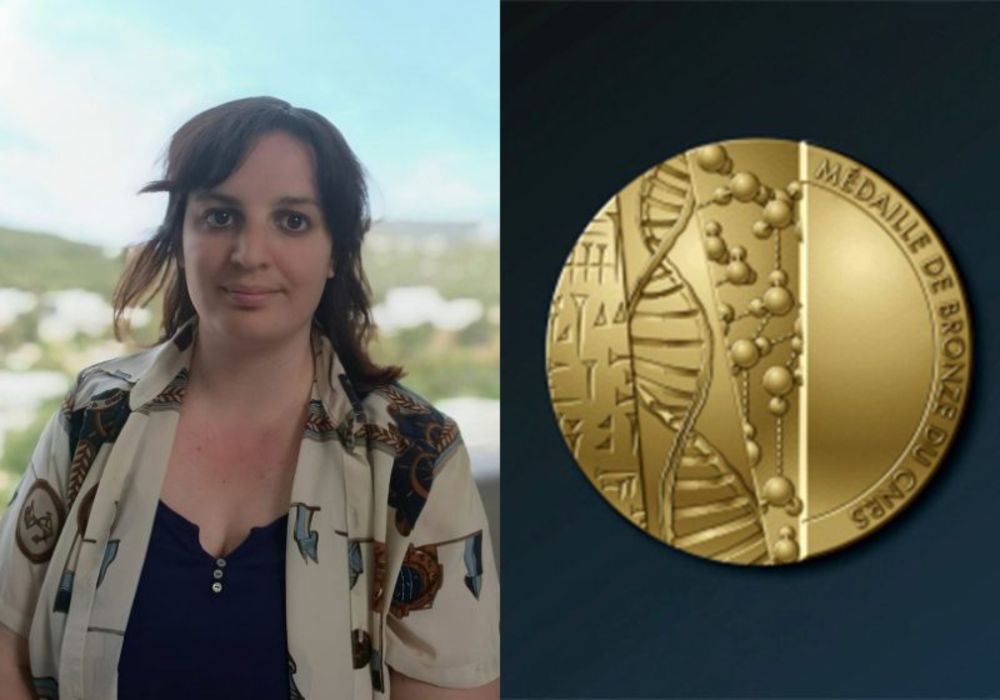
Sham Tlili, winner of the CNRS 2025 bronze medal - IBDM | Institut de Biologie du Développement de Marseille
A distinction that rewards a promising and already fruitful scientific career.
www.ibdm.univ-amu.fr
June 27, 2025 at 9:00 AM
🥇Sham Tlili has been awarded the CNRS 2025 Bronze Medal! She studies how physical forces shape living tissues by using mouse stem cell models known as gastruloids. A unique blend of physics & biology.
🔗 Read more: www.ibdm.univ-amu.fr/sham-tlili-w...
🔗 Read more: www.ibdm.univ-amu.fr/sham-tlili-w...
Thank you so much for sharing your thoughts on our article!
I am very excited to share my first news&views article doi.org/10.1038/s415... discussing the exciting paper www.nature.com/articles/s41... by @pflenne.bsky.social lab! Thanks to the editors @naturephysics.bsky.social for giving me this chance 📣💥🎊

Marangoni flows underlie symmetry breaking in early mouse gastruloids - Nature Physics
Spherical aggregates of mouse stem cells exhibit symmetry breaking by forming an elongated axis. This extension is driven by a recirculating Marangoni-like tissue flow, providing insights into the tis...
www.nature.com
April 10, 2025 at 6:33 PM
Thank you so much for sharing your thoughts on our article!
Excited to share that IBDM (Institut de Biologie du Développement de Marseille) is expanding its research groups this year! A great place for developmental biology and interdisciplinary research located on the beautiful Marseille-Luminy campus!
Deadline for applications: March 30th, 2025
Deadline for applications: March 30th, 2025
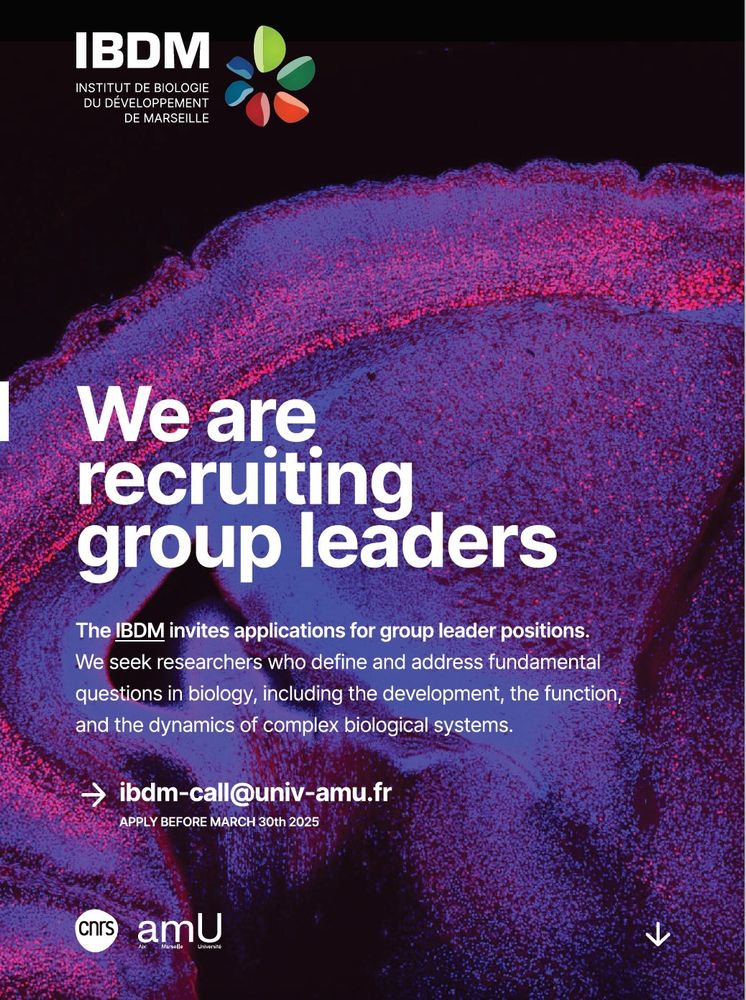
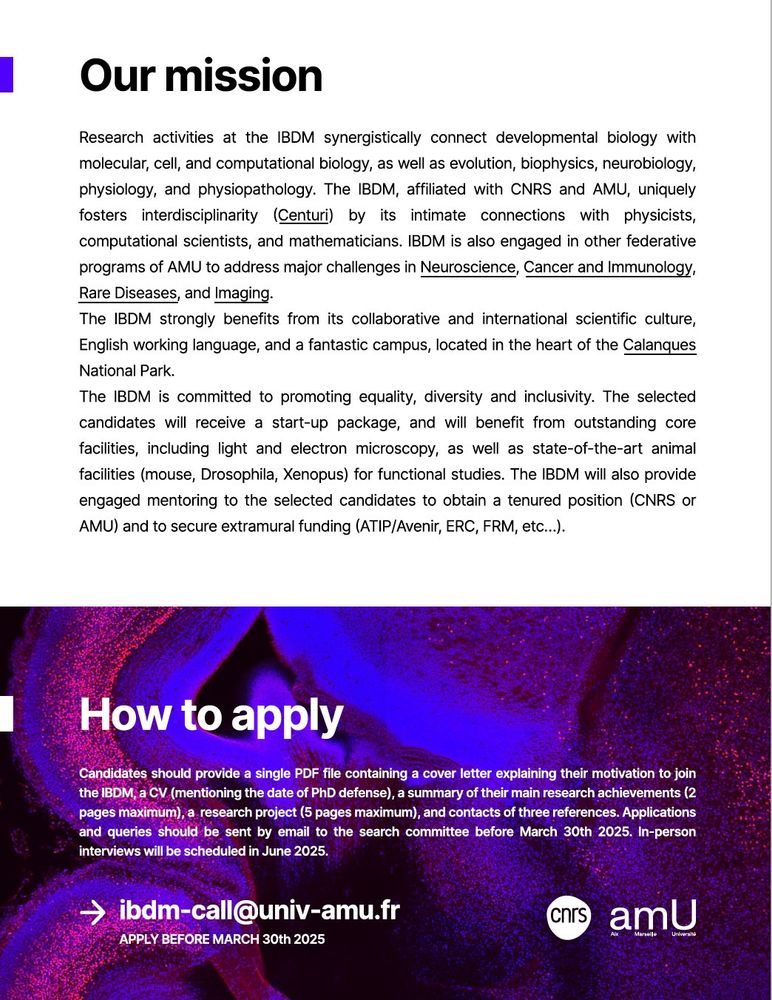
January 17, 2025 at 7:11 AM
Excited to share that IBDM (Institut de Biologie du Développement de Marseille) is expanding its research groups this year! A great place for developmental biology and interdisciplinary research located on the beautiful Marseille-Luminy campus!
Deadline for applications: March 30th, 2025
Deadline for applications: March 30th, 2025
Thrilled that our team clinched both 1st and 2nd place in the image contest! 🥇🥈 Huge applause for everyone’s creativity and excitement in front of the microscope. Let’s keep inspiring each other! 💪✨ #Teamwork #Science
Discover the winners of the FBI Image Contest 2024🔬
🥇Place: Vanessa Weichselberger (IBDM-Université Aix-Marseille)
🥈Place: Dalia El Arawi (IBDM)
🥉Place: Frédéric Fercoq (Musée National d'Histoire Naturelle-Unité MCAM)
🏆 Congratulations to them!
👏 A big thank you to all the participants!
🥇Place: Vanessa Weichselberger (IBDM-Université Aix-Marseille)
🥈Place: Dalia El Arawi (IBDM)
🥉Place: Frédéric Fercoq (Musée National d'Histoire Naturelle-Unité MCAM)
🏆 Congratulations to them!
👏 A big thank you to all the participants!

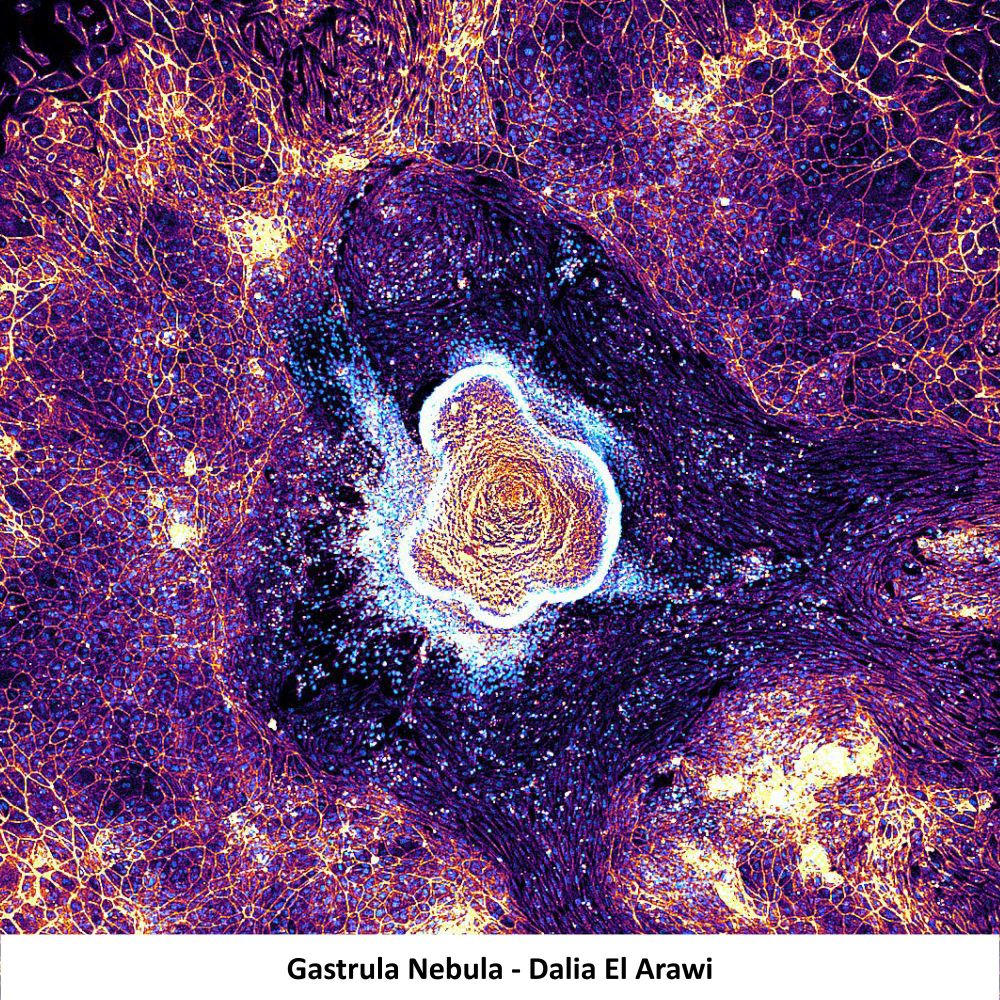
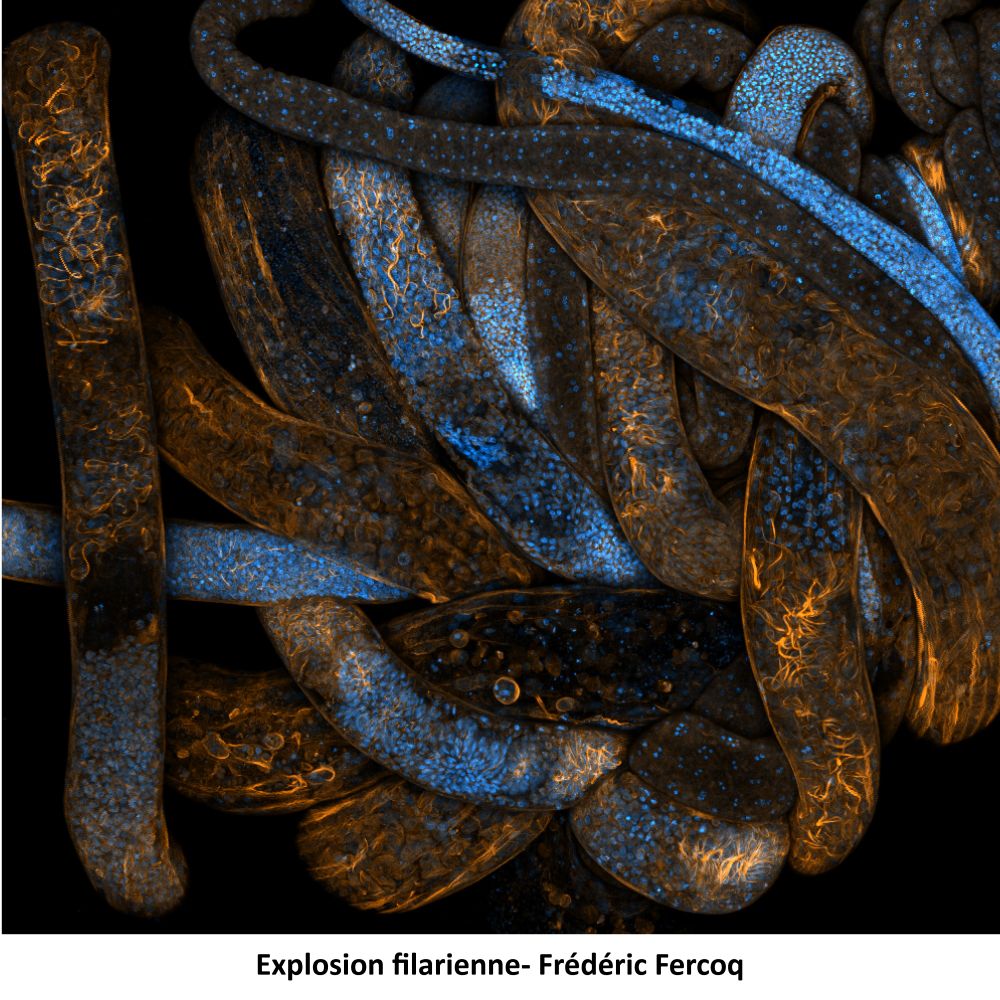
December 15, 2024 at 2:17 PM
And usually, the sky is blue in Cassis, near Marseille!
📣Exciting meeting ahead!
Join us at Shaping Life 3 in beautiful Cassis next June!
www.atoutcom.com/shaping-life/
@justinmcrocker.bsky.social @guignardlab.bsky.social @bulutkarslioglu.bsky.social @dudinlab.bsky.social @flowerwhatelse.bsky.social @laghalab.bsky.social @sfbd.bsky.social
Join us at Shaping Life 3 in beautiful Cassis next June!
www.atoutcom.com/shaping-life/
@justinmcrocker.bsky.social @guignardlab.bsky.social @bulutkarslioglu.bsky.social @dudinlab.bsky.social @flowerwhatelse.bsky.social @laghalab.bsky.social @sfbd.bsky.social

November 19, 2024 at 7:35 AM
And usually, the sky is blue in Cassis, near Marseille!
Vikas Trivedi's @LabTrivedi @EMBLBarcelona @the_prbb and my group @Equipe_lenne @IBDMmarseille @centuri_ls are recruiting for a Postdoc project on the emergence of mechano-genetic patterns using embryonic organoids!
Start Date: Feb 2023 or later
Informal inquiries are welcome!
Start Date: Feb 2023 or later
Informal inquiries are welcome!
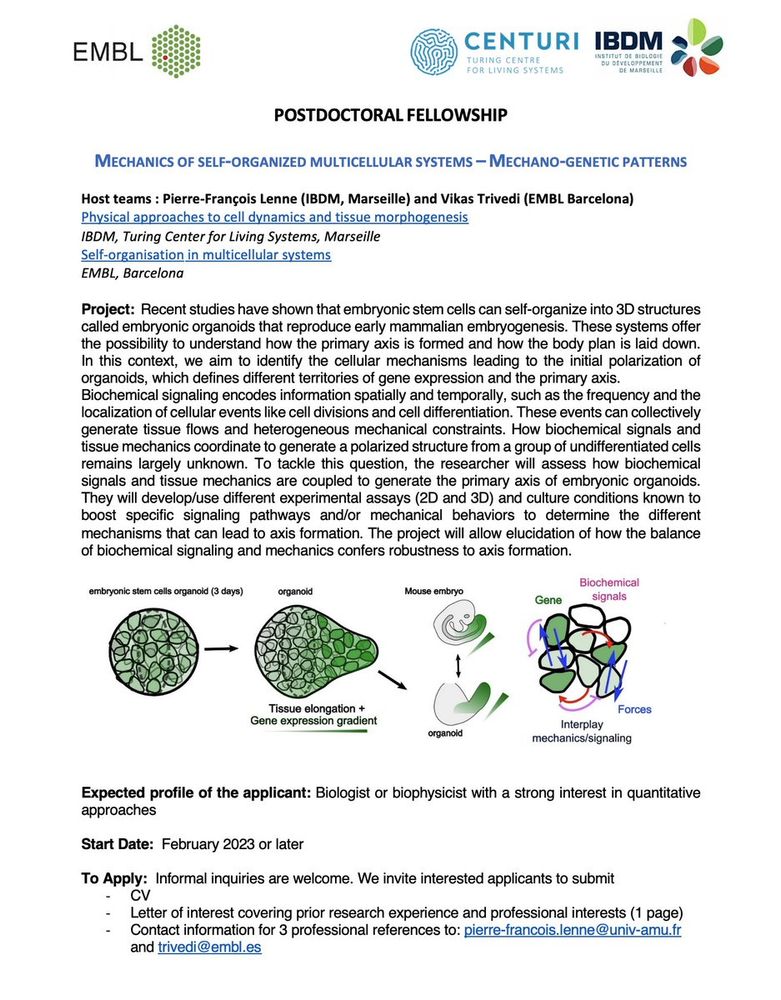
December 1, 2024 at 4:40 PM
Vikas Trivedi's @LabTrivedi @EMBLBarcelona @the_prbb and my group @Equipe_lenne @IBDMmarseille @centuri_ls are recruiting for a Postdoc project on the emergence of mechano-genetic patterns using embryonic organoids!
Start Date: Feb 2023 or later
Informal inquiries are welcome!
Start Date: Feb 2023 or later
Informal inquiries are welcome!
How do cell-cell contacts remodel in vivo? We address this question here:
biorxiv.org/content/10.110…
biorxiv.org/content/10.110…
Two-point optical manipulation reveals mechanosensitive remodeling of cell-cell contacts in vivo
Biological tissues acquire reproducible shapes during development through dynamic cell behaviors. These events involve the remodeling of cell contacts driven by active cytoskeletal contractile forces. However how cell-cell contacts remodel remains poorly understood because of lack of tools to directly apply forces at cell-cell contacts to produce their remodeling. Here we develop a dual-optical trap manipulation method to impose different force patterns on cell-cell contacts in the early epithelium of the Drosophila embryo. Through different push and pull manipulations at the edges of junctions, the technique allows us to produce junction extension and junction shrinkage. We use these observations to constrain and specify vertex-based models of tissue mechanics, incorporating negative and positive mechanosensitive feedback depending on the type of remodeling. We show that Myosin-II activity responds to junction strain rate and facilitates full junction shrinkage. Altogether our work provides insight into how stress produces efficient deformation of cell-cell contacts in vivo and identifies unanticipated mechanosensitive features of their remodeling. Significance statement The highly organized tissues and organs that form our body emerge from internal dynamic activities at the cellular level. Among such activities, cell shape changes and cell rearrangement, cell extrusion and cell division sculpt epithelial tissues into elongated sheets, tubes and spherical cavities. Remodeling of cell-cell contacts, powered by actomyosin contractility, is key to all these transformations. Although much is known about the molecular machinery and biochemical signals that regulate remodeling of cell contacts, there is a lack of approaches to directly probe the mechanics of cell contacts and therefore assess their ability to resist or deform in response to mechanical loads. We developed an experimental technique to manipulate and exert contractile and extensile forces to cell-cell junctions. Our results lead to a specific physical model of junctional mechanics, with implications in the modeling of collective cell behavior in epithelial tissues. ### Competing Interest Statement The authors have declared no competing interest.
www.biorxiv.org
December 1, 2024 at 4:40 PM
How do cell-cell contacts remodel in vivo? We address this question here:
biorxiv.org/content/10.110…
biorxiv.org/content/10.110…
The Munro (Chicago), Lenne and Rupprecht (Marseille) groups seek 2-3 postdoctoral fellows to join a newly funded (NSF/ANR) international collaboration on the multiscale dynamics of cell contact formation and remodeling.
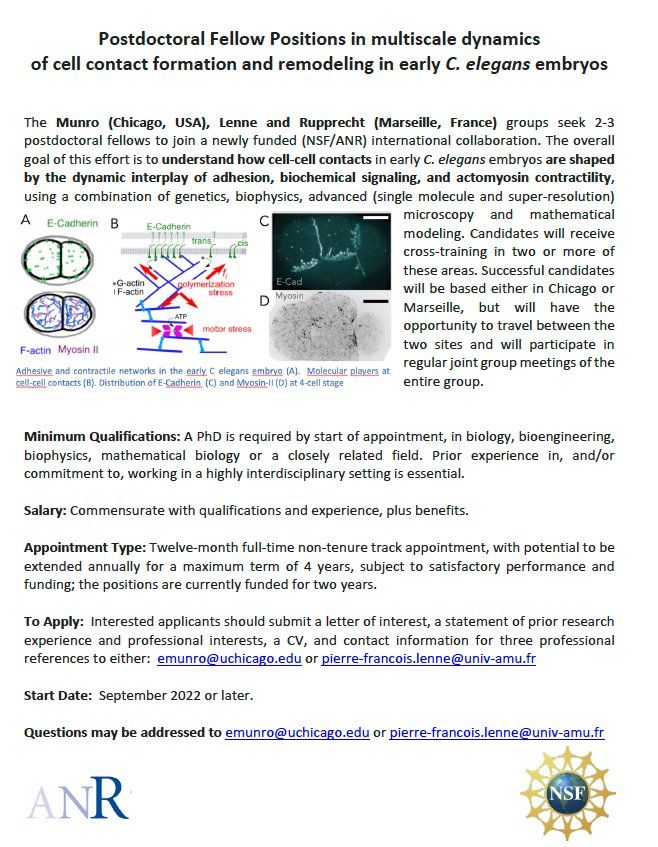
December 1, 2024 at 4:40 PM
The Munro (Chicago), Lenne and Rupprecht (Marseille) groups seek 2-3 postdoctoral fellows to join a newly funded (NSF/ANR) international collaboration on the multiscale dynamics of cell contact formation and remodeling.
Our code for force inference in epithelial tissues is available online!
Feel free to contact us if you're interested in using it or if you want to collaborate.
Code :Ref :
nature.com/articles/s4159… data.mendeley.com/datasets/78ng4…
Feel free to contact us if you're interested in using it or if you want to collaborate.
Code :Ref :
nature.com/articles/s4159… data.mendeley.com/datasets/78ng4…

December 1, 2024 at 4:40 PM
Our code for force inference in epithelial tissues is available online!
Feel free to contact us if you're interested in using it or if you want to collaborate.
Code :Ref :
nature.com/articles/s4159… data.mendeley.com/datasets/78ng4…
Feel free to contact us if you're interested in using it or if you want to collaborate.
Code :Ref :
nature.com/articles/s4159… data.mendeley.com/datasets/78ng4…
Very happy to welcome in our group Alice Gros @_AliceGros as a new Centuri @centuri_ls PhD student on a joint project with Léo Guignard @GuignardLab on morphogenesis of self-organized multicellular systems #Gastruloids
December 1, 2024 at 4:40 PM
Very happy to welcome in our group Alice Gros @_AliceGros as a new Centuri @centuri_ls PhD student on a joint project with Léo Guignard @GuignardLab on morphogenesis of self-organized multicellular systems #Gastruloids
Very grateful to great colleagues and pleased that our roadmap on multi-scale coupling of biochemical and mechanical signals during development is now onlinein IOPPBio @IOPPBio @WarmflashLab
@TimESaunders
@JgrosL
@a_michaut
@EdouardHannezo
@ZevGartner
ow.ly/eRun50EodEL
@TimESaunders
@JgrosL
@a_michaut
@EdouardHannezo
@ZevGartner
ow.ly/eRun50EodEL
Roadmap for the multiscale coupling of biochemical and mechanical signals during development - IOPscience
Roadmap for the multiscale coupling of biochemical and mechanical signals during development, Pierre-François Lenne, Edwin Munro, Idse Heemskerk, Aryeh Warmflash, Laura Bocanegra-Moreno, Kasumi Kishi, Anna Kicheva, Yuchen Long, Antoine Fruleux, Arezki Boudaoud, Timothy E Saunders, Paolo Caldarelli, Arthur Michaut, Jerome Gros, Yonit Maroudas-Sacks, Kinneret Keren, Edouard Hannezo, Zev J Gartner, Benjamin Stormo, Amy Gladfelter, Alan Rodrigues, Amy Shyer, Nicolas Minc, Jean-Léon Maître, Stefano Di Talia, Bassma Khamaisi, David Sprinzak, Sham Tlili
ow.ly
December 1, 2024 at 4:40 PM
Very grateful to great colleagues and pleased that our roadmap on multi-scale coupling of biochemical and mechanical signals during development is now onlinein IOPPBio @IOPPBio @WarmflashLab
@TimESaunders
@JgrosL
@a_michaut
@EdouardHannezo
@ZevGartner
ow.ly/eRun50EodEL
@TimESaunders
@JgrosL
@a_michaut
@EdouardHannezo
@ZevGartner
ow.ly/eRun50EodEL
Very fortunate to welcome today a new postdoc in the group, Valentin Dunsing @DunsingValentin, who will explore/exploit "fluctuations" in morphogenesis.
December 1, 2024 at 4:39 PM
Very fortunate to welcome today a new postdoc in the group, Valentin Dunsing @DunsingValentin, who will explore/exploit "fluctuations" in morphogenesis.
See our new perspective on cell junction mechanics written together with @Viasnofflab and @JFRupprecht_OM
zpr.io/HW2PN
zpr.io/HW2PN
Cell Junction Mechanics beyond the Bounds of Adhesion and Tension
Cell-cell adhesion is more than the sum of its molecular parts. In this perspective, Lenne, Rupprecht, and Viasnoff aim at bridging scales from adhesion molecules and actomyosin networks to junctional integrity and mechanical resistance of tissues and organs.
zpr.io
December 1, 2024 at 4:39 PM
See our new perspective on cell junction mechanics written together with @Viasnofflab and @JFRupprecht_OM
zpr.io/HW2PN
zpr.io/HW2PN
Check our latest manuscript on the nanoscopic segregation of polarity proteins in epithelia using superresolution. A project led by @PierreMangeol and a great collaboration with Le Bivic team.
biorxiv.org/content/10.110…
biorxiv.org/content/10.110…
Super-resolution imaging uncovers the nanoscopic segregation of polarity proteins in epithelia
Epithelial tissues acquire their integrity and function through the apico-basal polarization of their constituent cells. Proteins of the PAR and Crumbs complexes are pivotal to epithelial polarization, but the mechanistic understanding of polarization is challenging to reach, largely because numerous potential interactions between these proteins and others have been found, without clear hierarchy in importance. We identify the regionalized and segregated organization of members of the PAR and Crumbs complexes at epithelial apical junctions by imaging endogenous proteins using STED microscopy on Caco-2 cells, human and murine intestinal samples. Proteins organize in submicrometric clusters, with PAR3 overlapping with the tight junction (TJ) while PALS1-PATJ and aPKC-PAR6β form segregated clusters that are apical of the TJ and present in an alternated pattern related to actin organization. CRB3A is also apical of the TJ and weakly overlaps with other polarity proteins. This organization at the nanoscale level significantly simplifies our view on how polarity proteins could cooperate to drive and maintain cell polarity. ### Competing Interest Statement The authors have declared no competing interest.
www.biorxiv.org
December 1, 2024 at 4:39 PM
Check our latest manuscript on the nanoscopic segregation of polarity proteins in epithelia using superresolution. A project led by @PierreMangeol and a great collaboration with Le Bivic team.
biorxiv.org/content/10.110…
biorxiv.org/content/10.110…
Honoured and thrilled to become a EMBO member! A big thank you to all the great members of my team, past and present, and to my inspiring colleagues.
December 1, 2024 at 4:39 PM
Honoured and thrilled to become a EMBO member! A big thank you to all the great members of my team, past and present, and to my inspiring colleagues.
Signez la pétition : La recherche scientifique a besoin d’un plan d’urgencevia @ChangeFrance
chng.it/DjnW7knV
chng.it/DjnW7knV
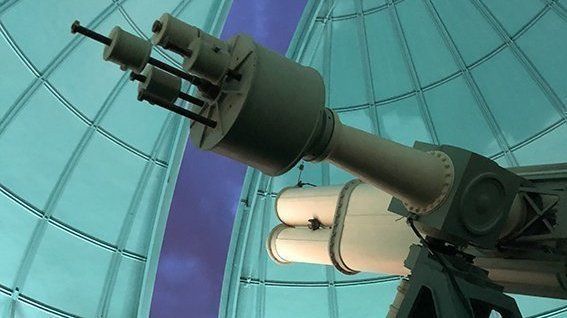
Signez la pétition
La recherche scientifique a besoin d’un plan d’urgence
chng.it
December 1, 2024 at 4:39 PM
Signez la pétition : La recherche scientifique a besoin d’un plan d’urgencevia @ChangeFrance
chng.it/DjnW7knV
chng.it/DjnW7knV
We seek to attract new PIs, computer scientists, physicists, or mathematicians with a theoretical and/or computational biology project, in the Turing Center for Living Systems (CenTuri) in Marseille.
View the offer here
⬇
centuri-livingsystems.org/wp-content/upl…
View the offer here
⬇
centuri-livingsystems.org/wp-content/upl…
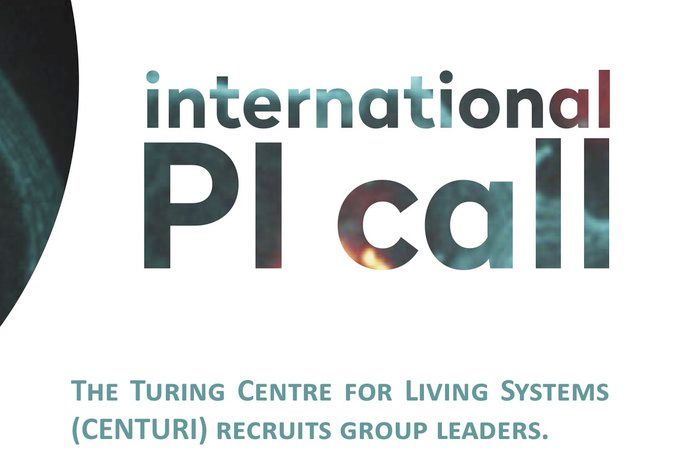
December 1, 2024 at 4:39 PM
We seek to attract new PIs, computer scientists, physicists, or mathematicians with a theoretical and/or computational biology project, in the Turing Center for Living Systems (CenTuri) in Marseille.
View the offer here
⬇
centuri-livingsystems.org/wp-content/upl…
View the offer here
⬇
centuri-livingsystems.org/wp-content/upl…
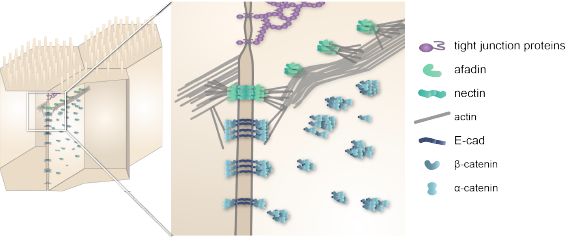
December 1, 2024 at 4:39 PM
Last days to register/submit an abstract to our meeting on "Self-organization in multicellular systems" in Cargèse, Corsica, Sept 30 - Oct 4.
centuri-livingsystems.org/csm2019/
centuri-livingsystems.org/csm2019/

December 1, 2024 at 4:39 PM
Last days to register/submit an abstract to our meeting on "Self-organization in multicellular systems" in Cargèse, Corsica, Sept 30 - Oct 4.
centuri-livingsystems.org/csm2019/
centuri-livingsystems.org/csm2019/

